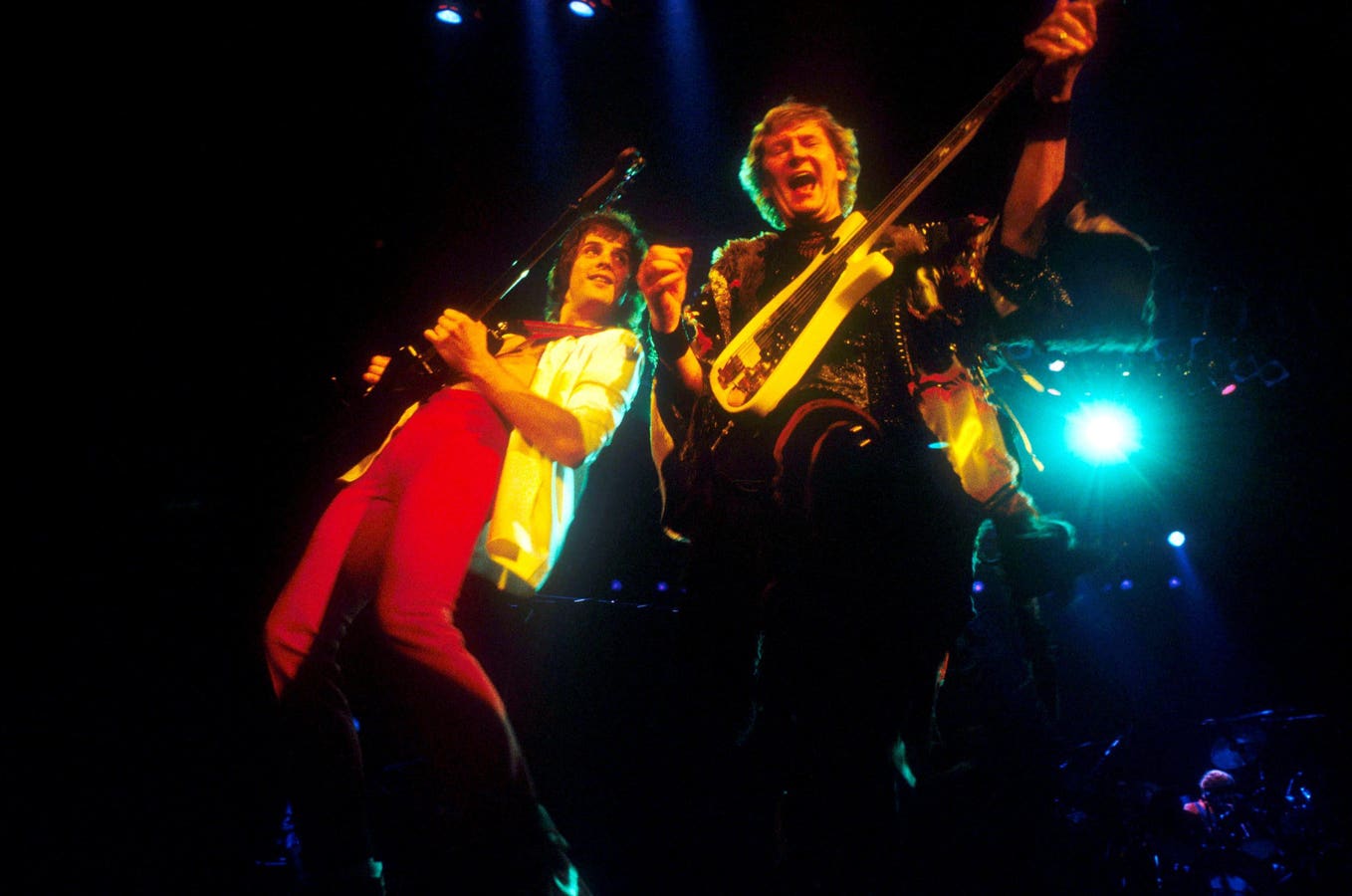When South African singer/guitarist Trevor Rabin first hooked up with former Yes musicians Chris Squire, Alan White and Tony Kaye in 1982, it was intended as Cinema, a new group with original material and without the weight of Yes’ legendary history. But when ex-Yes singer Jon Anderson entered the picture, Cinema morphed into a resurrected Yes—with encouragement from their record label Atlantic Records.
“I was pretty adamant about it,” Rabin today recalls of his initial feelings that Cinema should start with a clean slate. “It’s funny. I think it was Alan White saying to me, ‘Are you okay not being the singer?’ I said, ‘Look, on the one hand, you could say I’ve been fired as the singer. But what have we benefited from? We’ve got bloody Jon Anderson in, and he sounds incredible on this stuff.’”
Released on November 11, 1983, in the U.S., the resulting album, 90125, by the new Yes lineup was unlike any of the other albums recorded by the British progressive rock group, who achieved success during the ‘70s. Instead of epic-length compositions, the music on 90125 was an accessible-sounding merger of rock and New Wave with shorter songs. As a result, 90125 elevated the group’s popularity with the MTV audience and yielded the number-one smash “Owner of a Lonely Heart,” one of Yes’ most popular and beloved songs to this day.
Before finding greater fame and fortune with Yes. Rabin had been in the South African rock band Rabbitt, which achieved huge recognition in their home country during the mid-1970s—an experience that he later describes as a “big fish in a small pond. But for us, that pond was our life. So outside of the fact that we were all very anti-apartheid, we’d refused to play certain there was one gig. They said, ‘Oh, you can’t have mixed audiences.’ And we said, ‘We’re not playing unless it’s mixed.’ And we got away with it, and it was mixed.” He also recalls the heavy media coverage of Rabbitt at the height of their popularity: “I remember the drummer recently said to me, ‘I think we sold more newspapers than records.’”
However, the recognition factor to Rabin was different when he relocated to London in 1978. “So I’d experienced that kind of adulation [with Rabbitt] if you like. And then I moved to London where I was walking through Heathrow. Some girls passed me on the other way in the airport, and I was walking with a friend of mine. I turned my head, and he said, ‘What are you doing?’ And I said, ‘Well, you know I just don’t want to be—’ He said, ‘You don’t want to be recognized?’ I said, ‘Well, I guess.’ And he said, ‘You can’t get arrested in England. No one knows who the f*** you are.’ So that became a rude awakening.”
After Rabbitt, Rabin had a record deal with Geffen, which didn’t last long. At the time, he had been working on his demos, one of them included a song called “Owner of a Lonely Heart.” Rabin says today that he had an inkling of the song’s potential. “There were a couple of people I went to when Geffen dropped me,” Rabin recalls, “and I sent out tapes. One tape I sent out was to Ron Fair, who was then at RCA – a really great record guy and producer. And when he got the tape he called me, very excited. He said, ‘Look, I really want to do a deal with you. You have a smash hit here.’ And he said, ‘”Owner of a Lonely Heart.”’ I said, ‘Oh, wow.’
“He did a version of it with somebody to show a different way of doing it. And then he called me back and said, ‘No, I think the way you’ve done it is the way it should be done.’ So he was the first guy to recognize it. Ron really believed in it. So I knew going in that this was one we had in the back of our pockets.”
Beginning in 1982, Rabin joined forces with bassist Chris Squire, drummer Alan White and keyboardist Tony Kaye — all of them Yes alums — for their new musical project after Squire came across Rabin’s demos. “When Chris, me and Alan and Tony were rehearsing for nine months, it was under the name Cinema,” says Rabin. “So it was a very fresh thing. There were no rules. We didn’t quite know what we were doing. All we had were these demos that I had actually written during a development deal with Geffen Records. And then Geffen dropped me, so I had to look to do something, and I landed up with Chris and Alan and Tony.”
The whole dynamic within Cinema changed with the arrival of founding Yes singer Jon Anderson. According to Brian Ives’ liner notes for the 2004 reissue of 90125, Squire played some of the new material that Cinema were working on to Anderson, who responded favorably to it and was invited to sing. That marked the start of the eighth Yes lineup.
“There are bits and pieces like on “Changes” and the chorus of “Owner of a Lonely Heart” where I sing those parts,” says Rabin. “And Jon said, ‘Oh, those are great.’ So when Jon got on, the writing was on the wall and the record company said, ‘You can’t not call this Yes. We know we’ve got a hit. It can be utilized for this and that.’ And, you know, my integrity of saying, ‘Let’s call it something new,’ everyone said, ‘Yeah, yeah, yeah, okay.’”
Another huge part of 90125’s success has to be attributed to the presence of Trevor Horn (who previously replaced Anderson as Yes’ lead singer in 1980) as producer; along with his involvement with Yes, Horn had helmed such hit records by ABC and Frankie Goes to Hollywood during the early and mid 1980s. “I got on really well with Trevor Horn,” Rabin says. “We had different ideas. He was very much, you know, ‘6 o’clock, have a joint, and then have a listen.’ But a great guy to work with. I mean, it becomes clear once you see that after I finished 90125 and even after Big Generator where he didn’t stay—he didn’t last the project. But thereafter, I did a load of sessions for him: Seal, Frankie Goes to Hollywood, Tina Turner. So I’ve always worked well with him. I haven’t done it for a while because of the film thing, but he’s a good guy.”
In addition to “Owner of a Lonely Heart,” other standout songs from the sleek-sounding 90125 included the sweeping “It Can Happen,” the fiery “Changes,” the quirky and funky “Leave It,” and the dramatic anthem “City of Love.” Along with its modern, state-of-the-art sound, the record reflected the new Yes in terms of the cover art: a computer-generated design instead of the previous fantasy imagery by artist Roger Dean or the bubble logo.
“Owner of a Lonely Heart” reached number one on the Billboard chart; 90125 became a huge commercial success, giving Yes a creative second wind and earning the band a Grammy Award for the instrumental “Cinema.” For his part, Rabin emerged as one of the driving forces behind the rest of the band’s subsequent album releases Big Generator (1987), Union (1989) and Talk (1994). As Ives wrote in the reissue’s notes: “Without Trevor Rabin, the band probably wouldn’t have reunited. He provided Squire, White, Anderson, and Kaye with an artistic shot in the arm.”
In looking back at his time with Yes, Rabin acknowledges it was a different experience from the one he had with his previous band Rabbitt. “With Yes, the recognition wasn’t something new to me. But the band getting successful on this level was completely new to me. And I realized once [90125] had been out for a while, that it was new to everybody. Yes never had a record like this. So we were all in the same boat in a sense.”
Since leaving Yes after the Talk album, Rabin has forged a career as a music composer for numerous movies. But his Yes past hadn’t completely left him—in 2010, he joined former Yes members Jon Anderson and Rick Wakeman for the group Anderson, Rabin and Wakeman; seven years later, Rabin was inducted with Yes into the Rock and Roll Hall of Fame. He also praises the late Chris Squire and Alan White, the Yes members Rabin had worked with on the band’s ‘80s and early ‘90s albums. “Having Chris and Alan as the rhythm section was like a bloody Sherman tank,” he says. “It was an awesome experience. They were solid and big and bold…a fantastic rhythm section. And I was very close to Chris and Alan. We were very good friends.”
Rabin recently released his latest album, Rio, his first solo rock record with vocals in more than three decades. “I’ve been gone for 34 years when I got to do this because I hadn’t done a rock album [in a while],” he says. “So when I got to do this, even though I’m incredibly old, it felt fresh to me. That freshness, I think, was the same as 90125 because it was [this particular Yes lineup’s] first encounter together.”
Read the full article here





